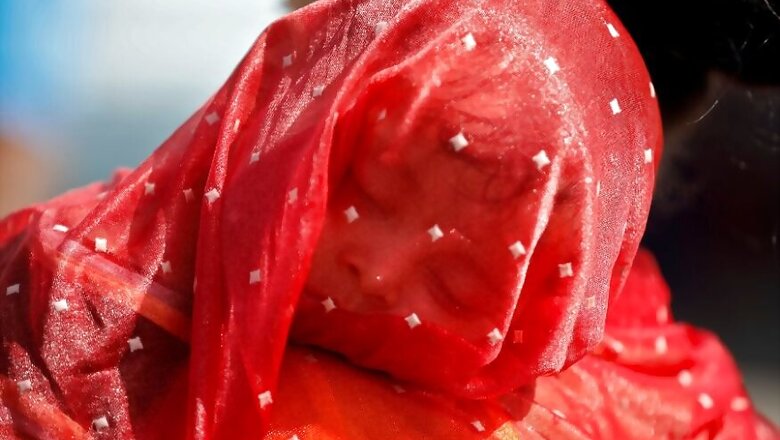
views
One of the major and understated reasons behind India’s relative success in initially slowing down the growth of Covid-19 can be credited to our large rural population.
More than two-thirds of our population (close to 68%) live in rural areas. They had been isolated till now from what is essentially an urban pandemic in India. The two reasons behind this – less mobility and lower density of population compared to urban areas.
But worryingly, the situation is changing now.
The Central Government has identified 145 new districts, a large percentage of which are rural, that have reported new cases over the past three weeks and could emerge as potential coronavirus epicentres in the near future. Half of these districts are in Assam, Chhattisgarh, Jharkhand, Uttar Pradesh, Odisha and Madhya Pradesh.
These districts have reported 2,147 active cases, accounting for 2.5% of the total cases in the country. Twenty-six of these districts have more than 20 active cases, as well.
The easing of lockdown has resulted in better mobility from highly infected urban areas to relatively unscathed smaller towns and villages, leading to a sudden spike of infection in rural India.
Millions of migrants have returned from big cities to their villages in Bihar, Uttar Pradesh, Madhya Pradesh, Chhattisgarh and Jharkhand, resulting in a high number of cases in these five states.
“It is primarily because of the return of migrant workers from Covid-19 hotspot states that the cases increased in eastern India,” said a Health Ministry official.
“As the rush of migrant workers was huge, there was no proper screening of passengers at railway and bus stations. Therefore, many took infections from one state to another.”
Uttar Pradesh saw a surge of 369 cases on June 2, taking the state tally to 8,729. Out of these, 2,404 cases are of migrant workers.
Barabanki District here, which had no cases on May 1 has now witnessed 159 infections with returning migrants accounting for around half the number.
Jaunpur, which had five cases as on May 10, now reports 180. Almost 20% of Etawah’s 56 cases are in migrants returning back home.
Bihar has so far reported 4,155 coronavirus cases, 85% of which have been registered during the last month. Alarmingly, 82.19% of these (2,903) have been migrant workers who have returned to their homes and villages. From these, 1,763 have come from the three severely affected states of Maharashtra, Gujarat and Delhi.
While Patna has the highest caseload, there has been a sharp rise in the rural districts of Munger (195 cases), Madhubani (185 cases) and Rohtas (174 cases).
Jharkhand also witnessed a massive increase in the number of cases since May 1. The state had only 113 cases with 12 out of the total 24 districts affected at that time. The capital, Ranchi accounted for 83 of these.
Now, the total number of cases has now gone up to 712 with all the districts reporting infections. While Ranchi has recorded an additional 55 cases in the last month, there has been a surge in infections in rural districts with the influx of migrant workers.
The number of cases has risen from 3 to 103 in Garhwa and 3 to 91 in Hazaribagh during this period. East Singhbhum has also seen a spurt and has now reporting 72 cases.
The story is no different in Chhattisgarh. Mungeli District reports the highest number of cases in the state at 84. There has been an increase in Jashpur (41 cases) and Rajnandgaon (37 cases).
The state which did not record any new case between May 6 and May 14, suddenly saw a surge and has now reported 564 infections.
Rural districts in Madhya Pradesh have seen a recent spike which include Neemuch (238 cases from 51 on May 15), Satna (24 cases), Annupur (17 cases), Bhind (40 cases), Jhabua (12 cases), among others.
Ganjam is the most severely hit district in Odisha with 458 cases. More than 80,000 workers have returned to the district leading to an increase in the number of cases.
Incidents of migrants getting off trains before reaching the designated station by pulling the chain to escape quarantine have also been reported.
There has also been a sudden surge of coronavirus cases in rural West Bengal post May 19, which is after Shramik special trains were allowed to enter the state.
Cases in Uttar Dinajpur have gone up from 2 on May 15 to 163 on June 3. Similarly, Murshidabad has seen a rise of 97 cases from 6 to 103 in the same time period.
Out of the total 732 Districts in India, 406 were affected by Covid-19 on April 18. In one-and-a-half months, this number has increased to 653 by June 3, with a majority of new districts being rural.
Till the last week of May, rural districts accounted for 21% of the total number of cases in India. This number is expected to rise as 57 lakh migrants have been transported back to their villages in Shramik trains and at least 40 lakh others in buses by June 2.
Any significant rise in the number of Covid-19 cases in rural India could lead to catastrophe due to the existing poor health and infrastructure system, which could collapse.
To put this in perspective, rural India has just 3.2 government hospital beds per 10,000 people. There is an acute shortage of doctors, specialists and equipment especially in the densely populated states of Uttar Pradesh and Bihar.
With most Covid-19 cases being reported from metropolitan cities and towns, rural India had not needed to ramp up its testing numbers.
But with restrictions eased amid a gradually lifting lockdown, millions of migrant workers are back home now and there is an urgent need to test, isolate and trace contacts.
If authorities fail to do so, rural India may become the next Covid-19 hotbed.




















Comments
0 comment